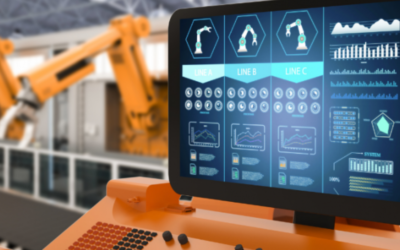5G for Smart Buildings: The Rise of Automated Systems and AI-Driven Applications
18
July 2022
Arti Loftus
Originally posted on IoT Evolution World
The rapid innovation of technology has created a new digital age, in which new devices and applications are already making lasting impacts on both our work world, and our society.
Technology has helped add ease and optimization into many of the mundane daily processes that we handle at work and in our personal lives. One of the most impactful technologies brought forth during the digital revolution is the Internet of Things (IoT), as the devices have paved the way for the creation of the “SMART” industry.
A smart building uses technology, such as Internet of Things (IoT) sensors, building management systems, artificial intelligence (AI), and augmented reality to enable efficient and economical use of resources, while creating a safe and comfortable environment for occupants. On top of resource utilization, smart buildings also offer automation opportunities, predictive maintenance, and real-time insights.
The creation of these buildings has already begun, with the global smart building market being valued at $67.60 billion in 2021, and expected to be $80.62 billion by the end of 2022. While there are plenty of smart buildings today, continued growth is expected, with experts predicting a stunning CAGR of 22.2 percent, and a market value of $328.62 billion by 2029.
“Despite the obvious advantages smart buildings offer, there are certain challenges that enterprises face when they decide to transform a building into a smart one,” said, Roy Timor-Rousso, CMO at Pente, a company offering private 5G for enterprise, which works both indoors and out. “For example, a variety of devices and applications go into the creation of a smart building. This means businesses must not only have the budget to accommodate numerous technologies, but they also need the digital know-how to adopt and implement everything correctly. Depending on the company, this may be out of their IT department’s wheelhouse.”
One of the main challenges for most organizations who attempt to transition into a smart building is the challenge of in-building connectivity, Timor-Rousso explained.
“In order for a smart building to work to its fullest potential, the devices implemented must be able to communicate and work together all in real-time, which requires high-level and secure networking,” he said.
High-rise commercial buildings with concrete walls, steel/metal fire doors and complex structures present a hostile environment to many radio solutions. The range of the chosen connectivity becomes paramount, as it has a direct impact on not only the signal strength and communication reliability but also the deployment cost and complexity.
To tackle this issue, enterprises have begun leveraging private 5G networks to achieve the levels of connectivity necessary to assure the devices, and the smart building itself, work efficiently and seamlessly. According to a new forecast from IDC, the global market for private LTE and 5G wireless infrastructure is tipped to grow almost fourfold during the next five years and be worth a whopping $8.3 billion in 2026.
“5G, paired with the ability to enhance Wi-Fi, including WiFi6 and WiFi6-E is going to be extremely important paired with IoT and edge computing that allows high end functions like AI to run in real time,” Timor-Rousso said. “5G is simply a standard that allows data to move faster over the air, the architecture of the networks that support 5G are truly what will make it unique. We’ve learned a lot with 4G, and as 5G ramps up, the ultra-fast speeds can support low-latency applications, including autonomous systems.”
With 5G, enterprises not only have improved speeds and lower latency, but also the ability to connect massive amounts of sensors and to process that information in real time. These sensors will form the central nervous system of the building, allowing maintenance or support staff to not only address issues immediately, but get ahead of potential issues employing new technologies like machine learning, computer vision, and artificial intelligence.
“5G paired with private network capability and the added value of putting more compute power at the edge of the network will truly start to automate critical operations,” Timor-Rousso said. “General examples could be automated sensors that report on elevator maintenance or control things like automated lighting or temperate settings based on people movement. Back-office functions like content delivery can be much more efficient over 5G private networks, delivering content directly on site. Hosting specific applications on local networks like augmented and virtual reality, gaming, and other high bandwidth/low latency intensive applications will also be possible, in ways we could not have dreamed of only a few years ago.”
Overall, the smart building journey is not without challenges, and it might be daunting at times. However, in failing to take the plunge, businesses risk losing ground by missing out on tremendous opportunities for unique value creation. Now, with the availability of private 5G networks, enterprises can finally attain high levels of indoor connectivity that will allow them to fully create a smart building and reap in all the benefits of the new digital age.
The Inevitable Explosion of Enterprise 5G Networks
Today, technological innovations are rapidly reshaping the landscape of a variety of industries, and none more so than the introduction of 5G. While 5G networks began rolling out in the United States and around the world in 2018, the technology is now expected to fuel transformative new technologies, not just for consumers but also for businesses, infrastructure, and defense applications. The rapid spread and adoption throughout the country has already led to the advent of private 5G networks.
For Industrial IoT, Will the Future of Enterprise 5G Networks be Federated?
As more industrial companies implement more connected solutions, the concept of federated networks is taking off as an opportunity for entrepreneurial exploration and a strong alternative to legacy “telecom” providers who are fighting to maintain their “walled gardens.”
With The Historic Infrastructure Bill Signed Into Law in the United States, Educators Have More Resources Than Ever To Move Forward
Yesterday, the long-promised Infrastructure Bill was finally signed into law by President Biden, following a successful negotiation across the aisle in Washington, DC.
One of the most exciting aspects of the bill is access to high-speed broadband, critical for the new world of digital learning and working.


